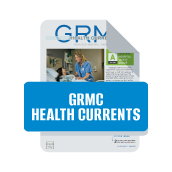
Colorectal cancer: Know why you should get tested and your options
3 minutes
Colorectal cancer—cancer that starts in the colon or rectum—is a major cancer killer in the U.S. But it doesn’t have to be. That’s because screening for colorectal cancer saves lives. There are several screening options—you’ll read about them below. But first, here’s a look at who is most at risk for colorectal cancer and how it develops.
Who’s most vulnerable?
Your risk of leaving your doctor’s office with a diagnosis of colorectal cancer increases with age. About 90% of all cases occur in people 50 and older. Risk also rises if you have:
- Inflammatory bowel disease, such as Crohn’s disease or ulcerative colitis.
- A rare inherited condition, such as Lynch syndrome.
- A personal or family history of colorectal cancer or colorectal polyps.
Most colorectal cancer begins as a polyp, a noncancerous growth in the rectum or colon. Over time, a polyp may turn into a life-threatening cancer. Screening saves lives because it can find polyps, which can be removed before they become cancerous. Screening can also find colorectal cancer early, before symptoms start and when treatment works best.
Your choices
Screening tests fall into two main categories:
Stool-based tests. These check the stool for possible signs of cancer. They’re done at home, and no bowel prep is required. But abnormal results must always be followed up with a colonoscopy. These tests include:
- The fecal immunochemical test (FIT). It uses antibodies to look for tiny amounts of blood in the stool that might be a sign of cancer or large polyps. You collect a small amount of stool and return the kit as instructed.
How often you need it: Yearly.
- Guaiac-based fecal occult blood test (gFOBT). This uses a chemical reaction to detect blood in the stool. It’s done in the same way as the FIT kit.
How often you need it: Yearly.
- Stool DNA testing. It looks for abnormal sections of DNA from cancer or polyp cells that often get into stool. You collect the entire stool sample and return the kit as instructed.
How often you need it: Every three years.
Visual tests. These tests look inside the colon and rectum for any abnormal areas that might be cancer or polyps. A bowel prep with strong laxatives and possibly an enema is required. These tests include:
- Colonoscopy. Doctors use a flexible lighted tube with a small camera at its end to look at the entire colon and rectum. If doctors find polyps, they can be removed during the test.
How often you need it: Every 10 years if results are normal.
- Virtual colonoscopy. This imaging scan of the colon and rectum lets doctors look for polyps or cancer. If they see something suspicious, a follow-up regular colonoscopy is necessary.
How often you need it: Every five years.
Time to talk
If you’re 45 or older, talk with your primary care provider about which test is right for you—each has pros and cons. You may need to be screened at a younger age if you’re at higher risk for colorectal cancer. Most important: Any test is better than no test. Whichever one you choose, the most important thing is to get regular screening. Meet our GRMG Board Certified General Surgeons who have been nationally recognized for colorectal surgery.
Sources: American Cancer Society; American Society of Clinical Oncology; Centers for Disease Control and Prevention
© Coffey Communications, Inc.



